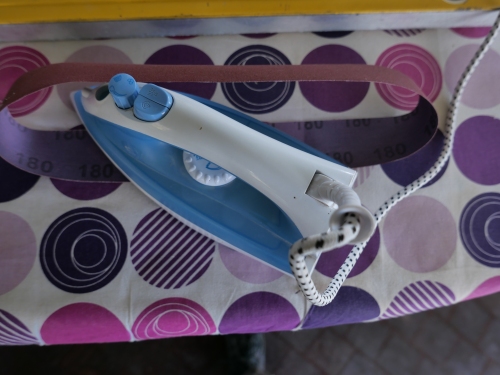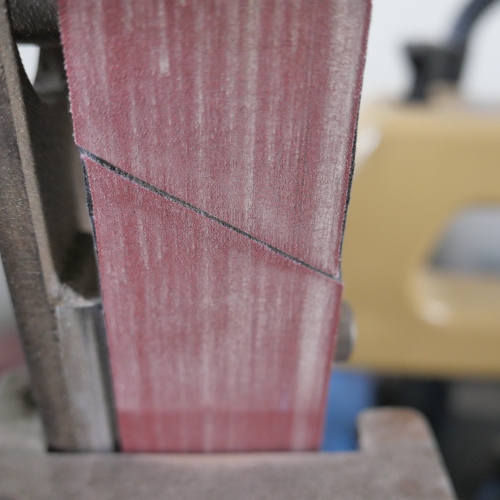Making Sanding Belts
by John
This idea is not original. I spotted it on YouTube.
I have a very nice small bench belt sander made by Sorby UK. I don’t use it often, because the Australian made Radius Master is much more versatile and powerful, but occasionally it is the tool of choice. Problem is the belts. They are a really odd size. Not available on ebay, and they are expensive. So when I saw this method, I decided to try it.
Basically, you buy a roll of relatively inexpensive 50mm wide sanding paper, and make your own belts. The issue is, the join.

I have had this roll, and several others, for years, using a few inches at a time.

I removed the old belt, cut it along its join, and used it as a model to cut some pieces off the roll. The angle of the cut was 30/60º. I used Tullen cutters in preference to scissors.

And this is the method of the join. Use “Iron On Mending patch”. Freely and cheaply available on Ebay, and in haberdashery shops.

I asked SWMBO if she had some spare IRON for my workshop, and this was produced. Sorry about the confusing ironing board pattern.
Important: the ends of the cut sandpaper are precisely aligned, and the side edges are lined up against a straight edge. Then the mending patch, cut a bit oversize, is laid on the join, and the heated iron is applied according to the instructions on the mending patch. In this case the iron was heated to “cotton” heat (whatever that means) and pressed down for 25 seconds. Best to use some brown paper underneath, otherwise the patch will glue to the ironing board cover.
Then I tried it. Click on the arrow to see a short video.
So, the test was surprisingly successful. Later I made another belt, and applied the patch obliquely, at the same angle as the join. It was MUCH improved, totally removing the noise of the patch running over the workpiece. I would certainly recommend this modification.

This patch was applied straight across, but it was a bit noisy and I kept wondering if it would hold. It stayed intact. But an oblique patch is better.

After some use, the join opened about a millimeter, but remained intact. I probably should have let it cool totally before using it. Or maybe the patch fabric in this case was a little stretchy.
I think that this will be a good method, and I will continue to use it. It is inexpensive. I got 4 joins per $AUD5 patch. I suspect that I overdid the size of the patch, and could probably get double the number of joins from this size material. Try it!

Thanks for the tip John , I too have a non standard sander in good condition but unused , must try your system
LikeLike
I haven’t been writing much lately due in part to excruciatingly painful carpal tunnel syndrome, coronavirus pandemic and battling constant attack on my computer and accounts from servers in Russia, China and the US. It has been exhausting and depressing. I shut down my accounts at Facebook and Instagram yesterday.
But have watched every video and read every word of your blogs for a few years now with interest and pleasure. I am not a machinist though I have familiarity with the equipment and what you are doing. Your precision at sub-millimeter scale amazes me. Though I’m not particularly into war equipment, the complexity of your current project is as fascinating as watching you build a triple expansion steam engine.
I shall send pics of some of the equipment I have built and/or worked with before long. I think you’ll find it interesting. Speaking of which…
For sanding glass I use 106″ belts ranging from #40 to #600 grit. For polishing, a cork belt. All are used wet. Additionally, I have other belt sanders for wood and metal work. The 106″ belts are quite expensive.
I have tried all sorts of glues, hot and cold to repair belts – both new and used – that came apart at the seam with no luck whatsoever. Got no help from 3M either. I’m interested in how the repair works out. Meanwhile, I’ll head to the fabric store!
Aloha.
LikeLike
It is great to hear from you Richard. I am sorry about your problems with health and hackers. They (the hackers) are bastards who should be caught and given Singaporean punishment (birching). Have you been advised to have an operation for carpal tunnel? Surgery has a very high success rate.
LikeLike
Thanks great
LikeLike
Hello John I am having difficulty navigating through this word press system. I know this is off topic but I wanted to speak to you concerning the G E C Gemini but can not figure out how to do it. I get regular updates to my email from yourself but am unable to reply . Lets hope this one gets through
jimmymouse
LikeLike
Hi, jimmymouse, That one came through. I doubt that I will have the electronic expertise to help you, but I know someone who probably can, if you can describe the problem.
LikeLike